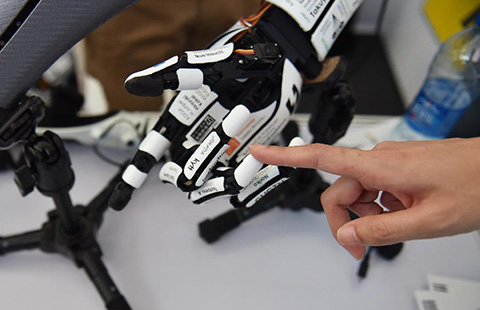Laser radar to help cities combat smog
Updated: 2015-06-23 07:37
By Zhao Lei(China Daily)
|
||||||||
Advanced equipment developed in China will go on sale next year to monitor air pollution
Chinese engineers are developing laser radar equipment that can monitor and analyze air pollutants such as PM2.5, the leader of the project has revealed.
"Laser radar is a new monitor and measurement tool in the environmental and meteorological fields, capable of monitoring airflow and particulate matter and other air pollutants," said Song Yubin, a radar expert at the Beijing Huahang Radio Measurement Institute.
"The apparatus has a narrow beam, supreme directivity and excellent resistance to outside electromagnetic elements. It can conduct three-dimensional, omnidirectional scans from the surface to the planetary boundary layer, so it can monitor almost everything in the air that affects our health."
The institute, part of the Third Academy of the China Aerospace Science and Industry Corp, specializes in radar and photoelectric equipment and previously focused on the space sector, said publicity officer Zhao Yi.
The institute's leaders, seeing the huge potential of China's environmental protection market, have decided to utilize their radar expertise to help cities tackle one of their biggest concerns - PM2.5, particulate matter with a diameter smaller than 2.5 microns that can penetrate the lungs and harm health.
According to the Ministry of Environmental Protection, PM2.5 was the biggest contributor to air pollution in 74 monitored cities during the first quarter of the year.
Song said a range of radar equipment called SkyLidar is being developed at the institute. The instruments are designed to monitor the distribution of dust and haze, forecast sandstorms, calculate levels of particulate matter and analyze the concentration of chemical pollutants such as sulfur dioxide and nitrogen dioxide.
Currently, the country's environmental authorities mainly use gravimetric analysis or beta ray attenuation instruments to monitor PM2.5 concentration in the air, Song said.
The institute's instruments are smaller than the existing equipment and use less energy, and can therefore be easily mounted on vehicles, ships, aircraft and even satellites, Song added. He said the devices are due to go on sale next year.
Earlier reports said cities such as Tianjin and Hefei have bought imported laser radar equipment to detect PM2.5.
Zhao Yi and Jiang Wenyu contributed to this story.
zhaolei@chinadaily.com.cn

 Liu visits Houston Museum of Natural Science
Liu visits Houston Museum of Natural Science
 Liu meets Tsinghua Youth team in Houston
Liu meets Tsinghua Youth team in Houston
 Men get into women's shoes for fun
Men get into women's shoes for fun
 Millions in harmony on Yoga Day
Millions in harmony on Yoga Day
 Liu visits CI in Pittsburgh
Liu visits CI in Pittsburgh
 Shenzhen Maker Week kicks off
Shenzhen Maker Week kicks off
 Chinese wrap up Zongzi to mark upcoming Dragon Boat Festival
Chinese wrap up Zongzi to mark upcoming Dragon Boat Festival
 A Chinese Garden in a Sister City
A Chinese Garden in a Sister City
Most Viewed
Editor's Picks

|

|

|

|

|

|
Today's Top News
Liu Yandong plays basketball diplomacy
Wang Yang hails S&ED
Tsinghua students flying high
Official underlines national defense technology innovation
New anti-corruption app sparks instant flood of public reports
Chinese Premier emboldens state firms' int'l industrial cooperation
CI in Pittsburgh welcomes
vice-premier
Sichuan and Pittsburgh unveil
new school
US Weekly

|

|






